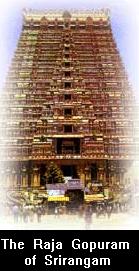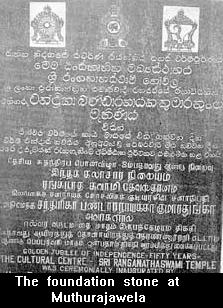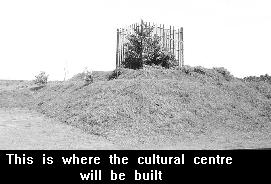
Rs. 600 m for Muthurajawela peace complex or mumbo-Jumbo?
 Two
cabinet ministers have launched a 600 million-rupee project to build a
multi-religious temple at Muthurajawela, believing it will ward off ill
effects from a temple in South India and help restore peace in Sri Lanka. Two
cabinet ministers have launched a 600 million-rupee project to build a
multi-religious temple at Muthurajawela, believing it will ward off ill
effects from a temple in South India and help restore peace in Sri Lanka.
But religious elders and businessmen who have been approached for funds
feel the scheme is based on some religious belief or an attempt to blame
the whole ethnic crisis on supernatural forces instead of facing reality
and taking responsible action.
Grasping at straws and blaming external factors for the war that is
raging in Sri Lanka, the two ministers have made the extraordinary request
for funds on the advice of some South Indian priests who say that a Vishnu
temple in Tiruchchirapalli has malefic effects on Sri Lanka.
This temple, according to those priests, is facing Sri Lanka, thus casting
evil effects. They believe this phenomenon is largely responsible for the
turmoil in the country.
The two ministers pushing the project are Anuruddha Ratwatte and Lakshman
Jayakody.
Dennis Ratwatte, a trustee of the proposed cultural centre project,
is convinced that the temple in South India is bringing ill luck on Sri
Lanka and something has to be done to counter it.
Mr. Ratwatte told The Sunday Times it was not Lord Vishnu who was not
looking upon Sri Lanka unfavourably but his benevolent view was being obstructed
by a building, 35 feet above sea level.
This was completed by former Tamil Nadu Chief Minister M G Ramachandran
in 1983.
"It is this obstruction which is believed to be causing the havoc
in Sri Lanka. Indian priests have told us that in order to counter these
malefic effects, it is necessary to build a temple here. Located at the
same height, 35 feet above sea level, this place of worship should face
India and be surrounded by water. This is why Muthurajawela was chosen
by the Indian priests themselves," he said.
When we (I)visited the site at Muthurajawela (I) we found a foundation
stone laid and the area guarded by police.
Asked as to why this multi-religious concept is not being constructed
in Mannar, which is directly in line of the malefic rays, Mr. Ratwatte
said the conflict in that area did not permit such a venture.
He said the Indian priests from this temple in Trichy had told government
leaders, including the President, that the ill effects from this South
Indian temple had caused the war here.
He said assistance was being received from India too, to build the temple
here.
Businessmen told The Sunday Times that apart from a letter by Minister
Jayakody requesting funds for the project, they were given no other detail
of a scheme which some are describing as a project going from the sublime
to the ridiculous.
Plans are underway to sea-freight a massive statue of Lord Vishnu from
Tamil Nadu to Sri Lanka.
The project appears to be shrouded in secrecy because even Deputy Cultural
Affairs Minister A.V. Suraweera says he knows nothing about it.
Land Reclamation & Development Corporation Chairman G.F.P. Withana
said he had only been asked to begin filling the chosen site but knew nothing
more.
The two ministers were not available for comment.
But the first reaction from a Buddhist prelate was of shock and amazement.
The Ven. Kamburugamuwe Nayake Thera, former Vice Chancellor of the Buddhist
and Pali University said there was nothing wrong in building a cultural
centre for all religions, but to do so in order to ward off evil effects
from another religious site was "beyond comprehension."
Hindu Council President Yogendra Duraiswamy said it was believed by
some that this gopuram at the Srirangam temple brought ill luck to Sri
Lanka. "If this is so, why is it that no such ill effects have been
noticed in the areas of Tamil Nadu which are south of the southern gopuram?"
he asked.
Mr. Duraiswamy, regarded as one of Sri Lanka's top Hindu scholars, said
no acknowledged authority in Hindu temple construction had come up with
such a theory nor was there any scriptural reference to any such ill effects.
"I feel this is superstition and should not be taken seriously. Naturally
it follows that no counter measures need be taken to meet these so-called
ill effects," he said.
Mannar's Bishop Rayappu Joseph dismissed the whole theory saying evil
did not stem from any religious site but from within the hearts of human
beings.
"This is a political gambit to attribute all the nation's troubles
on evil spirits without taking responsibility for what has happened. This
is a diversion to take people away from the reality of the situation today.
Promoting religious amity is good. It is human beings in Sri Lanka who
are the cause for the present havoc in this country and certainly not any
religious site," Bishop Rayappu said.
The reaction among the businessmen was varied.
Aitken Spence Chairman Ratna Sivaratnam said both ministers had said
in a letter that malefic effects from the Trichy temple needed to be warded
off and financial support for this was required from the businessmen.
Asked whether it was worth spending so much on such a project he quipped
that peace at any cost was welcome but declined further comments.
Moosajees Chairman Asker Moosajee was more forthright. He said some
kind of religious star wars would not help solve the problems. He said
he believed evil effects were largely man made and it was unthinkable to
him to spend Rs. 600 million on such a project while millions of people
were facing stark poverty.
A more favourable response came from Associated Motorways Chairman Tilak
De Zoysa. He said the concept was admirable and important, bringing about
a multi-religious flavour such as in Kataragama and countering the ill
effects.
Eswaran Brothers Deputy Chairman D. Eswaran said he had already made
a contribution for the cultural centre here but he did not believe the
Vishnu temple had any malefic effects on Sri Lanka. "God Vishnu is
ever merciful and kind and will never cause ill effects on any country
or any place," he said. He said he felt the proposed temple in Sri
Lanka also would bring blessings.
Bogoda Premaratne, who heads a National Conference on Religion and Peace,
strongly condemned the proposed project at Muthurajawela saying religion
had now become an instrument of war.
"It sounds ridiculous and this is the wrong way of using religion.
Without educating people on religious values the easier way appears to
be to waste money on brick and mortar. If there has been any evil eye from
South India it has certainly not been from any building. Putting up statues,
temples and churches, has no effect on the youth of this country who should
instead be taught the values of religion.
"These are all outward shows. Evil is rooted in the hearts of people
and evil effects cannot be warded off in this manner. This is all mere
superstition," Mr. Premaratne said.
The cultural centre featuring Buddhist, Hindu, Muslim and Christian
components, is to be built on a filled marshy area on the Western side
of the buffer zone at Muthurajawela.
In ancient times Muthurajawela was one of Sri Lanka's famous rice bowls
for producing the best 'muthu samba,' before the Dutch canal development
scheme was implemented. 
At present Muthurajawela is a mangrove swamp protected under the Wetland
Conservation Project as a nature reserve for species of birds, butterflies,
reptiles and the elusive salt-water crocodiles.
Comprising 7,000 hectares, the Muthurajawela marsh and Negombo lagoon
wetland ecosystem is situated at the doorstep of the most densely populated
and economically important urban areas. It serves many uses and provides
numerous services, both to people and nature. The system however at present
is under severe stress caused by destructive fishing, encroachment, water
pollution, and expanding housing areas.
Fabrication and fable
A top Hindu historian has dismissed the evil effects theory as a fabrication,
fable or myth.
Prof. S. Pathmanathan, Vice Chairman of the University Grants Commission,
told The Sunday Times:
"The temple in Trichy is called the Srirangam. It is the principal
temple of the Vaishnavas (followers of Lord Vishnu) in South India, and
is perhaps the largest temple in the whole of southern India which has
survived.
"Now 2000 years old, the Srirangam has repeatedly undergone reconstruction.
In Sri Lanka a story has been propagated during the past 15 years that
there is an inscription of the 13th century which says that when the gopuram
of this temple is completed it will be inauspicious for Sri Lanka.
"As far as I am concerned there is no evidence of any such inscription.
This is a total fabrication. On this matter, I have even consulted Indian
historians who have also believed the story is a fabrication of someone's
vivid imagination.
"However, this story has taken hold of the imagination of the people
in Sri Lanka. I believe the story should be treated as a myth or fable.
"In 1981 when M G Ramachandran was Chief Minister, the gopuram
was completed. A very heavy carving, the Gopuram sits at a height of more
than 400 feet at the entrance to the temple.
The Srirangam Temple is on an island in South India and so the foundation
beneath the soil is loose. As a result, it is feared the whole construction
is very unstable. This has nothing to do with Sri Lanka.
"The temple mostly faces the eastern direction but the gopuram
is found on many walls of the temple. Srirangam has its own temple town.
This means that within each walled enclosure there are settlers, houses
and even subsidiary shrines including rows of shops and artists."
|
Editorial/Opinion Contents
|


![]()
 Two
cabinet ministers have launched a 600 million-rupee project to build a
multi-religious temple at Muthurajawela, believing it will ward off ill
effects from a temple in South India and help restore peace in Sri Lanka.
Two
cabinet ministers have launched a 600 million-rupee project to build a
multi-religious temple at Muthurajawela, believing it will ward off ill
effects from a temple in South India and help restore peace in Sri Lanka.

